
PREV ARTICLE
NEXT ARTICLE
FULL ISSUE
PREV FULL ISSUE
BERTHOLD NEBEL'S MINE SAFETY MEDALAuthor Harry Waterson submitted this summary of his longer article published in The Clarion, the print publication of the Pennsylvania Association of Numismatists (PAN).
Thanks! See the complete article for footnotes and much more information. -Editor
Digest version of The Clarion article published January, 2017 The United States Bureau of Mines (USBM) was established on May 16, 1910 by the Organic Act to deal with a wave of catastrophic mine disasters. 30,000 miners in the US were killed in the first decade of the 20th century. The USBM was dissolved on March 30, 1996. Among its many accomplishments was the creation of programs and technologies that contributed to the reduction of fatalities in mine disasters by 97% from 3,000 in 1907 to 98 in 1993. A major part of the USBM Mine Safety effort was the sponsorship of Mine Rescue and First Aid Contests in the United States. In June, 1922 Congress authorized $1,000 for the purchase and bestowal of trophies to be conferred by the Bureau of Mines, at the International Mine Rescue and First Aid Contest, upon miners who have performed noteworthy feats in rescue work in time of mine accidents and disasters. On June 8, The Commission of Fine Arts (CFA) received a letter from the acting director of the Bureau of Mines seeking advice as to the preparation of suitable designs for the trophies which may graphically symbolize the humanitarian efforts of the American miner. James Earle Fraser the sculptor member of the Fine Arts Commission initially suggested Adolph Weinman to sculpt the bas relief but he was not available. Berthold Nebel was his next choice. Nebel worked at the Carnegie Institute in Pittsburgh and his office was within easy walking distance to the USBM Laboratories just across campus. Research was easily accomplished. Nebel submitted designs for the Mine Rescue medal. Below are his final designs. 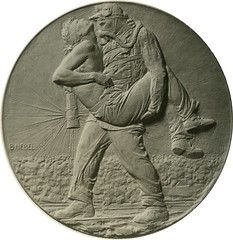 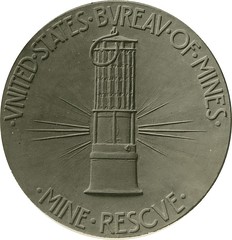
Images Courtesy of the U.S. Commission of Fine Arts "The obverse and reverse of the full size medal will be mounted side by side, and set in a frame of wood. The engraving proposed to commemorate the award will be placed on a separate plate." So wrote the Chairman of the CFA to Berthold Nebel. Berthold Nebel (1889-1964) was born in Basel, Switzerland and immigrated to the US with his parents when he was one year old. His family settled in New Jersey and he learned to model in clay working for a decorative terra cotta factory in Perth Amboy, NJ. He studied at night at the National Academy of Design and the Mechanics Institute. He also took classes with James Earle Fraser at the Art Students League and Fraser encouraged him to enter the Grand Prix de Rome competition. Nebel won the sculpture prize and with that a 3-year fellowship (1914-1917) at the American Academy in Rome. At the end of his fellowship, Nebel remained in Italy when the US entered the World War in 1917 and became a supply officer and interpreter for the Red Cross. Berthold Nebel returned to New York in 1920. He worked briefly as an assistant to James Earle Fraser in his McDougal Alley studio before accepting the position of Director of the School of Sculpture at Carnegie Institute of Technology in Pittsburgh, PA. According to Wikipedia Nebel won a competition sponsored by the Bureau of Mines to design and execute a Mine Rescue Medal. No corroboration has been found and it is doubtful a competition took place. The CFA was consulted on this from the beginning and they did not approve of competitions. In reference to another medal, they wrote: "The Commission deplores the requirement that the production of medals must be submitted to competition, in cases where their production involves an expenditure of more than $500. Unless a medal is produced under the immediate supervision of the artist who designs it, the artist's work is made of no avail." The CFA went on to say. "The Bureau of Mines...consulted the Commission as to a designer. Mr. Berthold Nebel, director of sculpture at the Carnegie Institution of Pittsburgh, was selected. Patient study of the technique of mine rescues and first aid, and frequent conferences with bureau officials on the one hand and this Commission on the other have resulted in medals highly satisfactory to all concerned." On January 3, 1923 three exhibits opened in the Department of Fine Arts, Carnegie Institute. One was an exhibition of paintings, drawings, designs and small bronzes by alumni of the American Academy of Rome. Berthold Nebel, a Fellow of the American Academy from 1914 to 1918, was represented by designs for the medal he had made for the mine safety work of the United States Bureau of Mines. The review of this exhibit said that Berthold Nebel was not adequately represented. "Nebel has taken what could be such a pedestrian medal as that of the United States Bureau of Mines and he has informed it with nobility. He was limited in the matter of using a gas mask and he has met the unimaginative committee's demand for exact representation of it and yet made this hideous equipment decorative and significant." On March 8, 1923 the Bureau of Mines again wrote the Commission of Fine Arts asking for assistance in securing a design for a First Aid award. Congress had approved an additional $1,000 in the USBM budget for fiscal year 1923 beginning July 1. The USBM gave the CFA the go ahead to have designs prepared for this award. Since this was to be a companion piece to the Mine Rescue plaque Berthold Nebel got the assignment and the Commission had Nobel's designs for review at their April 5 meeting. Here are the final designs. Nebel requested direction on what the exact wording on the reverse should be. 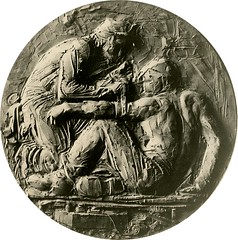 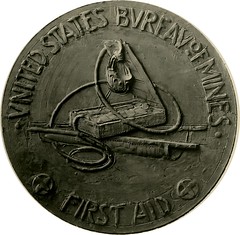
Images Courtesy of the U.S. Commission of Fine Arts Nebel turned out to be spot on with his query about the copy on the reverse. The Secretary of the Department of the Interior had ordered that the words "Department of the Interior" must appear whenever the words "Bureau of Mines" appear. The chairman of the CFA wrote to the Secretary of the Interior seeking relief from this order. He argued that the models for both medals were about complete and that adding the additional words "Department of the Interior" would overcrowd the medal. He asked that in this instance a waiver be granted, the words be omitted and the design approved. He defended the words 'United States' Bureau of Mines as it was necessary to distinguish the federal bureau from the state bureaus. He also cited the fast approaching August deadline as further reason to approve the medals as designed. In the event the Secretary turned him down. The 'United States' was reduced to 'US' and made part of the central design. 'US' split the lamp on the reverse of the Mine Rescue medal and was placed just below the stretcher on the First Aid medal. The upper double legend was created to name both the Department and the Bureau. This also led to an odd anomaly in the lettering. The artist had chosen to use the classical Roman tombstone 'V' as a substitute for 'U' in all of the lettering. However, when he moved 'Vnited States' from the legend to the central design of the medal, it became 'US.' This is the only time this writer has seen both 'U' and 'V' used in the same design to mean 'U.' These were the final designs as published by the CFA in 1926. The Department of the Interior got top billing. The first aid obverse and reverse are in the wrong order. Images Courtesy of the U.S. Commission of Fine Arts 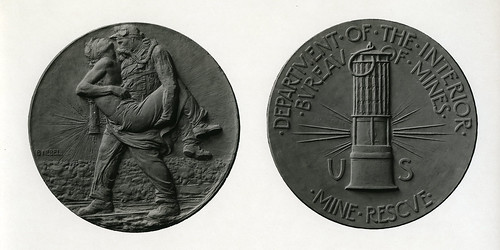 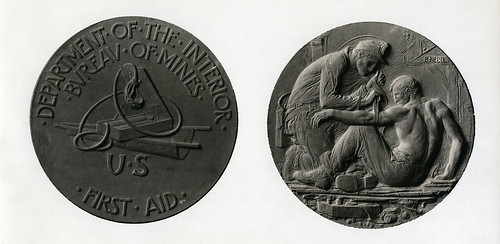 In addition to the plaques the Bureau of Mines intended to award. . ."Two medals, one for the winning team in first-aid and the other for the winning mine rescue team. . . authorized by congress and provided for by a special appropriation. . .designed by a commission of mining men." In the event only one medal was struck. It combined the first aid obverse with the mine rescue reverse. It made sense to use one mine safety medal to recognize the teams competing in both contests. Here is an example of the team medal from 1925 with the loop cropped for ease of illustration. 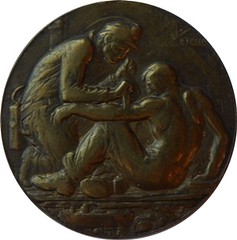 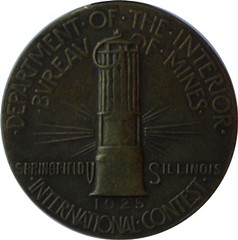 Medallic Art Company, New York (MACo) struck this medal. It is bronze with an integral loop, 1¼-inches in diameter. Only the 1923 issue is edge marked with the maker's name. The MACo No. is 1923-026. It is signed B. Nebel on the obverse in the upper right on the mine shaft ceiling timber support. On August 27, 28 & 29, 1923, the Seventh International First Aid and Mine Rescue Meet was held at the Bonneville Pavilion in Salt Lake City, UT. 55 first aid teams and 21 mine rescue teams competed. A total of 500 men participated usually in teams of 6. The Benton District team from Benton, IL won the Mine Rescue Contest and the Anaconda Mining Team from Great Falls, MT won the First Aid Contest. The 500 competitors all were recipients of the first Berthold Nebel Mine Safety medal. In addition to the medals each winning team was awarded the Congressional Bronze Medallion. This was a rectangular wooden board -approximately 1½x2½-feet with a beveled edge on which was mounted two 11-inch bronze circular bas-reliefs; one plaque with Nebel's mine rescue designs and one with his first aid designs. The reliefs were mounted backwards with the reverse to the left and the obverse to the right. Naming the plaque the 'Congressional Bronze Medallion' confused this writer for some time. With the exception of1924 these 'Congressional Medallions' and Mine Safety Medals were awarded through 1930. After a hiatus of 21 years the contests and awards were resumed in 1951 and continued on odd-numbered years until The Federal Mine Safety and Health Act of 1977 was passed creating the US Mine Safety & Health Administration(MSHA). This new agency began operations March 9, 1978 as part of the Department of Labor. MSHA took over the Mine Safety and Health obligations of the Bureau of Mines. Their continued use of versions of the Nebel Mine Safety Medal and Plaques is an ongoing subject of research. For more information about the Pennsylvania Association of Numismatists, see:
 Wayne Homren, Editor The Numismatic Bibliomania Society is a non-profit organization promoting numismatic literature. See our web site at coinbooks.org. To submit items for publication in The E-Sylum, write to the Editor at this address: whomren@gmail.com To subscribe go to: https://my.binhost.com/lists/listinfo/esylum All Rights Reserved. NBS Home Page Contact the NBS webmaster 
|